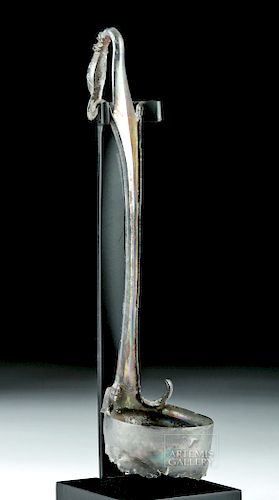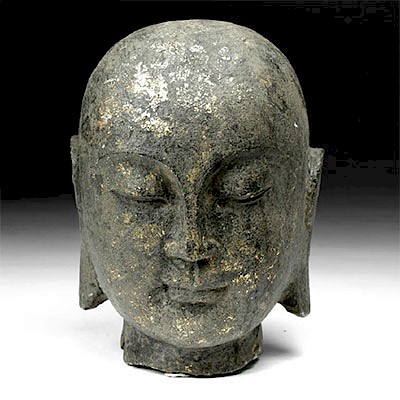Roman Silver Duck Ladle (Simpulum) - 90 g
Lot 71
About Seller
Artemis Fine Arts
686 S Taylor Ave, Ste 106
Louisville, CO 80027
United States
Selling antiquities, ancient and ethnographic art online since 1993, Artemis Gallery specializes in Classical Antiquities (Egyptian, Greek, Roman, Near Eastern), Asian, Pre-Columbian, African / Tribal / Oceanographic art. Our extensive inventory includes pottery, stone, metal, wood, glass and textil...Read more
Estimate:
$1,200 - $1,700
Absentee vs Live bid
Two ways to bid:
- Leave a max absentee bid and the platform will bid on your behalf up to your maximum bid during the live auction.
- Bid live during the auction and your bids will be submitted real-time to the auctioneer.
Bid Increments
| Price | Bid Increment |
|---|---|
| $0 | $25 |
| $300 | $50 |
| $1,000 | $100 |
| $2,000 | $250 |
| $5,000 | $500 |
| $10,000 | $1,000 |
| $20,000 | $2,500 |
| $50,000 | $5,000 |
| $100,000 | $10,000 |
| $200,000 | $20,000 |
About Auction
By Artemis Fine Arts
Nov 29, 2018
Set Reminder
2018-11-29 10:00:00
2018-11-29 10:00:00
America/New_York
Bidsquare
Bidsquare : Holiday Glitz - Ancient / Ethnographic Art
https://www.bidsquare.com/auctions/artemis-gallery/holiday-glitz---ancient-ethnographic-art-3672
What to give this holiday season? Think silver, gold, bronze, shiny, glittery, wearable, festive. We ship worldwide and handle all shipping in-house for your convenience. This is one sale you don't want to miss! Artemis Fine Arts info@artemisgallery.com
What to give this holiday season? Think silver, gold, bronze, shiny, glittery, wearable, festive. We ship worldwide and handle all shipping in-house for your convenience. This is one sale you don't want to miss! Artemis Fine Arts info@artemisgallery.com
- Lot Description
Roman, Imperial Period, ca. 1st to 3rd century CE. A cast silver ceremonial ladle with a long handle that ends in the head of a duck, swan, or goose - the bird's eyes and plumage nicely incised and its beak and frill of neck feathers very well defined. Just before the bowl and the duck terminal, the long handle is also decorated with twin curled flourishes. In ancient Rome, the ladle - called a simpulum or simpuvium - was used in the preparation and serving of ceremonial libations. It was also more generally just a utensil, depicted in vase paintings compositions of banqueting scenes aiding in the distribution of wine into cups. The style of this example - with a round bowl and a handle ending in the head of an animal, especially a duck - was a very long-lasting tradition, extending from the Greeks and Etruscans to the Romans. Weight: 90 grams Size: 7.5" H (19 cm); 8.375" H (21.3 cm) on included custom stand.
This piece has been has been tested for the presence or absence of particular elements via XRF elemental analysis. A basic 1-page summary of the XRF screening will accompany purchase, identifying each element present in the sample, as well as the quantity of elements present. A more complete analysis detailing historical data / comparisons is available for additional charge – please contact us.
Provenance: private Southern California, USA collection, acquired in the 1970s to mid-1980s
All items legal to buy/sell under U.S. Statute covering cultural patrimony Code 2600, CHAPTER 14, and are guaranteed to be as described or your money back.
A Certificate of Authenticity will accompany all winning bids.
We ship worldwide and handle all shipping in-house for your convenience.
#140703Loss to bowl as shown. Some dents and tears to lower peripheries of what remains of the bowl. The silver has attained a lovely warm patina with rainbow iridescence.Condition
- Shipping Info
-
All shipping is handled in-house for your convenience. Your invoice from Artemis Gallery will include shipping calculation instructions. If in doubt, please inquire BEFORE bidding for estimated shipping costs for individual items.
-
- Buyer's Premium



 EUR
EUR CAD
CAD AUD
AUD GBP
GBP MXN
MXN HKD
HKD CNY
CNY MYR
MYR SEK
SEK SGD
SGD CHF
CHF THB
THB














